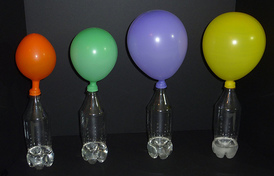Using the Limiting Reagent:
When using the limiting reagent, there are two formulas to follow
The first formula gives you an answer in moles
The first formula gives you an answer in moles
- (moles of the limiting reagent)(coefficient of the product/coefficient of the limiting reagent) = theoretical yield in moles
- (theoretical yield in moles)(the molar mass of the product) = theoretical yield in grams
EXAMPLE PROBLEM
For the balanced equation shown below, if 44.8 grams of C6H6OS were reacted with 159 grams of O2, how many grams of H2O would be produced?
2C6H6OS+17O2=>12CO2+6H2O+2SO3
the limiting reagent is C6H6OS The mass of H2O is then determined using the mass ratio from the balanced equation:
(mass of H2O)/(mass of C6H6OS)=108.12/252.4=(mass of H2O)/96.6
(108.12/252.4)*96.6=19.2
For the balanced equation shown below, if 44.8 grams of C6H6OS were reacted with 159 grams of O2, how many grams of H2O would be produced?
2C6H6OS+17O2=>12CO2+6H2O+2SO3
the limiting reagent is C6H6OS The mass of H2O is then determined using the mass ratio from the balanced equation:
(mass of H2O)/(mass of C6H6OS)=108.12/252.4=(mass of H2O)/96.6
(108.12/252.4)*96.6=19.2
Now that you are familiar with formula process when using a limiting reagent, we can determine the theoretical yield in grams by following these steps:
- Step 1 is to find the limiting reagent
- Once you have found the limiting reagent, step 2 is to fill in the numbers into the formulas
- After you have completed the first formula and gotten your answer in moles, you plug in the next few numbers into the second formula
- Once you have followed the second formula and gotten an answer in grams, you have used the limiting reagent.

